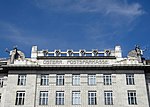Rooftop Remodeling Falkestrasse
Buildings and structures in ViennaCoop HimmelblauDeconstructivism
The rooftop remodeling Falkestrasse located in Vienna, Austria, is a Coop Himmelb(l)au architectural project. Architizer, About Coop Himmelblau, March 2012 The remodelling is an edition to a pre-existing traditional Viennese building. The law firm clients, Schuppich, Sporn, Winischhofer required more space in which Coop Himmelblau went up and out. The remodelling design commenced in 1983, with the final construction concluding in late 1988.
Excerpt from the Wikipedia article Rooftop Remodeling Falkestrasse (License: CC BY-SA 3.0, Authors).Rooftop Remodeling Falkestrasse
Biberstraße, Vienna Innere Stadt
Geographical coordinates (GPS) Address Nearby Places Show on map
Geographical coordinates (GPS)
| Latitude | Longitude |
|---|---|
| N 48.2083 ° | E 16.3807 ° |
Address
Biberstraße 6
1010 Vienna, Innere Stadt
Austria
Open on Google Maps











